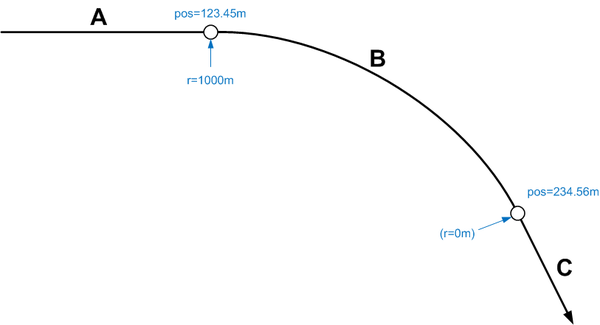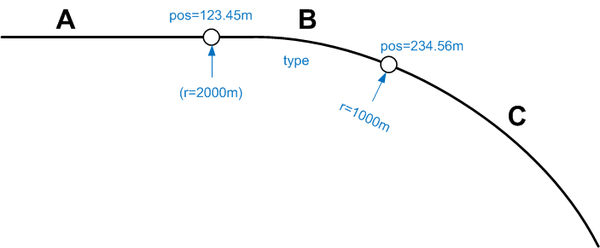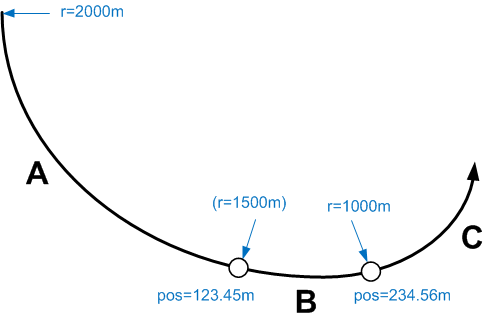IS:radiusChange
IS:radiusChange
Schema description / Schemabeschreibung
Position of IS:radiusChange in the XML-Tree / Position von IS:radiusChange im XML-Baum
- Parent: <radiusChanges>
- Children: <additionalName> (introduced with version 2.1), <any>, <geoCoord>, <states>
Multiplicity / Anzahl
Semantics / Bedeutung
A radiusChange defines a change of the radius and and/or superelevation on a track.
Attributes of IS:radiusChange / Attribute von IS:radiusChange
- id: XML-file-wide unique, machine-interpretable identity, required for later referencing that element internally. For a detailed explanation see Dev:identities.
XML-Datei-weit eindeutige, maschineninterpretierbare Identität, die für die spätere interne Referenzierung dieses Elements erforderlich ist. Für eine detaillierte Erklärung siehe Dev:identities. - code (introduced with version 2.1): Machine-interpretable string (e.g. an abbreviation) used for identification of the object across exchange partners, usecase specific uniqueness constraints may apply. Please see our description of the differences between id, code and human-readable identifiers.
Maschineninterpretierbare Zeichenkette (z.B. Abkürzung), die zur Identifizierung des Objekts auch bei Austauschpartnern verwendet wird, wobei spezifische Eindeutigkeitsbeschränkungen gelten können. Bitte beachten Sie unsere Erläuterung zu den Unterschieden zwischen id, code and menschenlesbaren Kennzeichnungen. - name: Established, human-readable short string, giving the object a name. Not intended for machine interpretation, please see our notice on human interpretable data fields.
Etablierte, menschenlesbare kurze Zeichenkette, die das Objekt benennt. Nicht zur maschinellen Interpretation bestimmt, siehe Hinweise zu menschenlesbaren Datenfeldern. - description: Human-readable, more detailed description as addition to the name. It should give additional explanations or hints to the contents of this element. Not intended for machine interpretation, please see our notice on human interpretable data fields.
Menschenlesbare, detailliertere Beschreibung als Ergänzung zu name. Sie soll zusätzliche Erläuterungen oder Hinweise auf den Inhalt dieses Elements geben. Nicht zur maschinellen Interpretation bestimmt, siehe Hinweise zu menschenlesbaren Datenfeldern. - xml:lang (introduced with version 2.1): This is a unique identifier of language. It uses basically the language standard IETF BCP 47 (external link) which may be different to ISO 639-1 (external link) or ISO 639-2 (external link). For mapping hints see relation to other standards (external link).
This defines the language used for name and description. Use <additionalName> to provide a name and/or description in other languages.
- pos: This is the position on a track defined as distance from its start (trackBegin) regardless the "absolute mileage" in @absPos.
Das ist die Position des Elements auf einem Track i.S. der realen Entfernung zum trackBegin. Sie ist damit unabhängig von der mit absPos modellierten Strecken-Kilometrierung.
|
- absPos: This is the position on a track as absolute mileage/chainage.
Das ist die Position des Elements im Referenzsystem der Strecken-Kilometrierung.
|
- absPosOffset (deprecated with version 2.1): The semantics of this attribute aren't very clear. It seems to be redundant to the definitions with mileageChanges in "overlapping regions".
- dir: (deprecated with version 2.5) This defines the validity of <radiusChange> along the track. Possible values are:
- up This denotes the direction from the <trackBegin> to the <trackEnd> (increasing relative position values).
- down This goes opposite to up (decreasing relative position values).
- radius The radius of the track in meters, which is either valid exactly at this point or from here until the next radiusChange element. Positive radius values describe a turn to the right w.r.t. the orientation of the track; negative values describe a turn to the left. For straight lines with a mathematical radius of ∞ metres, a values of radius = 0 m shall be used in railML®-files.
Der Radius eines Gleises in Metern. Modelliert wird der Radius entweder exakt an dieser Position oder aber für den hier beginnenden Gleisabschnitt bis zum nächsten radiusChange Element. Ein positiver Radius-Wert beschreibt eine Rechtskurve in Bezug zur Orientierungsrichtung des Tracks; eine Linkskurve ist durch negative Radius-Werte ausgewiesen. Für gerade Gleise mit einem mathematischen Radius von ∞ Metern muß auf Grund der Darstellbarkeit ein Radius von 0 m in den railML®-Daten angegeben werden.
- superelevation The superelevation of the track in millimeters, which is either valid exactly at this point of from here until the next radiusChange element. The superelevation shall be given in whole mm.
Die Überhöhung eines Gleises in Millimeter. Modelliert wird die Überhöhung entweder exakt an dieser Position oder aber für den hier beginnenden Gleisabschnitt bis zum nächsten radiusChange Element. Die Überhöhung sollte stets in ganzen Millimetern angegeben werden.
- geometryElementDescription (introduced with version 2.3) Specific geometric description either of this point or of the curve between this and the next radiusChange element (shall be used in particular for transition curves). Possible values are:
Spezielle geometrische Beschreibung entweder exakt für diese Position oder aber für den dort beginnenden Gleisabschnitt bis zum nächsten radiusChange Element. Dieser Parameter soll insbesondere für die Beschreibung von Übergangsbögen verwendet werden. Mögliche Werte sind:
- TS_cubicParabola begin of transition curve of type cubic parabola
- TS_parabola4 begin of transition curve of type 4th degree parabola
- TS_clothoide begin of transition curve of type clothoide
- TS_WienerBogen begin of transition curve of type Wiener Bogen
- TS_BlossBogen begin of transition curve of type Bloss Bogen
- TS_Sinusoide begin of transition curve of type Sinusoide
- TS_Cosinusoide begin of transition curve of type Cosinusoide
- SC end of transition curve (spiral - curve)
- other:anything: Any value that does not fit any value from the previous enumeration list, fulfilling the constraint: at minimum two characters, whitespace is not allowed. Please, apply Dev:usingAny accordingly.
Syntactic Constraints / Syntaktische Beschränkungen
- id: xs:ID, required
a string, starting with a letter (a..zA..Z) or an underscore (_),
followed by a non-colonized and non-spaced string consisting of letters, digits, points (.), dashes (-) or underscores (_) - code: xs:string, optional
- name: xs:string, optional
- description: xs:string, optional
- xml:lang: xs:language, language identification, optional
- pos: tLengthM (xs:decimal, 6 fraction digits, length value measured in meter); required; must be greater than or equal to zero, less than or equal to the track's length
- absPos: tLengthM (xs:decimal, 6 fraction digits, length value measured in meter); optional
- absPosOffset: xs:decimal, 6 fraction digits, length value measured in meter; optional
- dir: xs:string, generic type for more constrained direction statements: enumeration up, down; derived from tLaxDirection; optional
- radius mandatory
- superelevation optional
- geometryElementDescription optional
Best practice & Examples / Empfohlene Anwendung & Beispiele
Modelling of curves
Let’s consider a simple example where a circular arc (B) with radius 1000 meters is directly connected on both ends with straight track segments (A, C). The situation looks like this:
In railML®, horizontal curves are modelled using <radiusChange> elements that are positioned everywhere along the track where the radius changes. The railML® syntax for this example shall look like this:
<track ...>
...
<trackElements>
<radiusChange id="rC0815" pos="123.45" radius="1000"/>
<radiusChange id="rC4711" pos="234.56" radius="0"/>
</trackElements>
</track>
In this example, the first <radiusChange> point (rC0815) is situated at the connection of the straight track segment (A) with the circular arc (B). The parameter radius of the <radiusChange> element describes the new value of the radius (1000 meters) that is valid from there into the direction of track orientation. The track orientation is indicated by the arrow at the right end.
The second <radiusChange> point (rC4711) is situated at the connection of the circular arc (B) with the straight track segment (C). Like for the previous <radiusChange>, the parameter radius describes the new value of the radius that is valid from there into the direction of track orientation. Normally, this value should be infinite, but since infinite is not an explicit number, railML® uses the value 0 here, which is a virtual value and does not exist in reality.
Modelling of transition curves in railML® 2.3
With railML® 2.3 the element <radiusChange> has been extended by the new attribute geometryElementDescription. This attribute is an enumeration parameter, which provides the following entries to enable a more detailed description of transition curves:
- TS_cubicParabola
- TS_parabola4
- TS_clothoide
- TS_WienerBogen
- TS_BlossBogen
- TS_Sinusoide
- TS_Cosinusoide
- SC
- (any other)
The new attribute geometryElementDescription in the <radiusChange> element shall be used for modeling begin and end points of transition curves. Let’s consider an example where a straight track segment (A) is connected with a circular arc (C) of radius 1000 meters via a clothoide (B). The situation looks like this:
In railML®, the transition curve is modelled using two <radiusChange> elements that are positioned at the begin and at the end of the transition curve. The railML® syntax for this example shall look like this:
<track ...>
...
<trackElements>
<radiusChange id="rC0815" pos="123.45" radius="2000" geometryElementDescription="TS_clothoide"/>
<radiusChange id="rC4711" pos="234.56" radius="1000" geometryElementDescription="SC"/>
</trackElements>
</track>
In this example, the first <radiusChange> point (rC0815) indicates the begin of a transition curve of type Clothoide. Since the parameter radius is mandatory for every <radiusChange> element, a fixed value has to be provided although the main feature of a transition curve is its changing radius. It is recommended to use twice the value of the radius of the circular arc to which the transition curve is connected. In the given example, the value is 2000 meters. The second <radiusChange> point indicates the end of the transition curve and the begin of the circular arc. The circular arc has a radius of 1000 meters.
Modelling of a transition curve between two circular arcs in railML® 2.3
Let’s consider an example where a circular arc track segment (A) with radius of 2000 meters is connected with another circular arc (C) with radius 1000 meters via a clothoide (B). The situation looks like this:
Like described in the previous example, in railML®, the transition curve is modelled using two <radiusChange> elements that are positioned at the begin and at the end of the transition curve. The railML® syntax for this example shall look like this:
<track ...>
...
<trackElements>
<radiusChange id="rC0815" pos="123.45" radius="1500" geometryElementDescription="TS_clothoide"/>
<radiusChange id="rC4711" pos="234.56" radius="1000" geometryElementDescription="SC"/>
</trackElements>
</track>
In this example, the first <radiusChange> point (rC0815) indicates the begin of a transition curve of type Clothoide. Since the parameter radius is mandatory for every <radiusChange> element, a fixed value has to be provided although the main feature of a transition curve is its changing radius. In this example, the transition curve connects two circular arcs with radius 2000 meters and 1000 meters. Therefore, it is recommended to use the mean value of both radii as a virtual value for the transition curve radius. In the given example, the value is 1500 meters. The second <radiusChange> point indicates the end of the transition curve and the begin of the second circular arc. This circular arc has a radius of 1000 meters.
Notes / Anmerkungen
General information on positioning
Positive pos values describe the distance from the track's begin. The track length is derived from the pos value in <trackEnd>.
The absolute mileage refered to by absPos is usually found on technical drawings of the track layout or on mileage posts next to the track.
Open issues / Offene Punkte/Pendenzen
Not yet described. / Noch nicht beschrieben.


